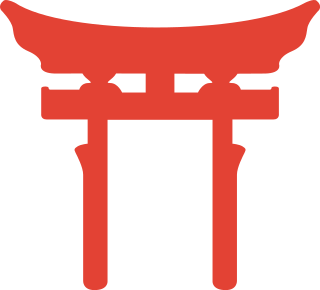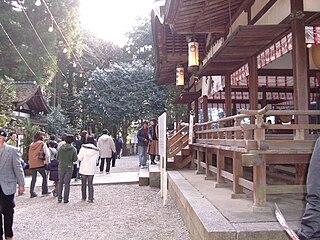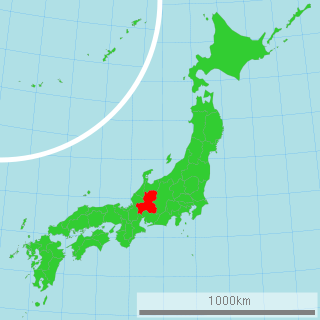In Shinto, Kotoamatsukami is the collective name for the first gods which came into existence at the time of the creation of the universe. They were born in Takamagahara, the world of Heaven at the time of the creation. Unlike the later gods, these deities were born without any procreation. The three deities that first appeared were:

Kami are the spirits or phenomena that are worshipped in the religion of Shinto. They can be elements of the landscape, forces of nature, as well as beings and the qualities that these beings express; they can also be the spirits of venerated dead persons. Many kami are considered the ancient ancestors of entire clans. Traditionally, great or sensational leaders like the Emperor could be or became kami.

Susanoo, also known as Takehaya Susanoo no Mikoto (建速須佐之男命) and Kumano Ketsumiko no Kami at Kumano shrine, is the Shinto god of the sea and storms. He is also considered to be ruler of Neno-Katasu-Kuni (根之堅洲國). He is married to Kushinadahime.

Ame-no-Uzume-no-mikoto is the goddess of dawn, mirth and revelry in the Shinto religion of Japan, and the wife of fellow-god Sarutahiko Ōkami. She famously relates to the tale of the missing sun deity, Amaterasu Omikami. Her name can also be pronounced as Ama-no-Uzume. She is also known as Ōmiyanome-no-ōkami, an inari kami possibly due to her relationship with her husband.

Ebisu, also transliterated Webisu or called Hiruko (蛭子) or Kotoshiro-nushi-no-kami (事代主神), is the Japanese god of fishermen and luck. He is one of the Seven Gods of Fortune, and the only one of the seven to originate purely from Japan without any Hindu influence.

Izumo-taisha, officially Izumo Ōyashiro, is one of the most ancient and important Shinto shrines in Japan. No record gives the date of establishment. Located in Izumo, Shimane Prefecture, it is home to two major festivals. It is dedicated to the god Ōkuninushi, famous as the Shinto deity of marriage and to Kotoamatsukami, distinguishing heavenly kami. The shrine is believed by many to be the oldest Shinto shrine in Japan, even predating the Ise Grand Shrine.

Ōkuninushi (大国主) is a divinity (kami) in Japanese Shinto. His name literally translates to "Great Land Master", and he is believed to be originally the ruler of Izumo Province, until he was replaced by Ninigi. In compensation, he was made ruler of the unseen world of spirits and magic. He is believed to be a god of nation-building, farming, business, and medicine.

[[Image:|thumb|]]

Ikoma Jinja (生駒神社) is a Shinto shrine in Ikoma, Nara, Japan. Generally called Ikoma Taisha (往馬大社). The formal name of the shrine is "Ikomaniimasu-Ikomatsuhiko Jinja (往馬坐伊古麻都比古神社)". This shrine is also known as "Ikoma-Taisha", which means "great shrine of Ikoma".

Mt. Kinka, also known as Kinkazan, is located in the heart of the city of Gifu, Gifu Prefecture, Japan, and rises to a height of 329 m (1,079 ft). Previously called Mt. Inaba, it has long served as the representative symbol of Gifu. It stands along the Nagara River, creating bountiful nature within the city. Though it is the most famous mountain in the city, Mount Dodo, to the north, is the tallest.

Kogane Shrine is a Shinto shrine located in the city of Gifu, Gifu Prefecture, Japan. First built in 135, it has long been considered a place to pray for financial blessings. Because it is located near the city center, approximately 150,000 worshippers visit the shrine over the three-day New Year's period. On April 5, the shrine hosts the Gifu Festival with Inaba Shrine and Kashimori Shrine. The nearby Kogane Hall can be used as a communications place for the citizens of the city.

Inaba Shrine is a Shinto shrine located at the base of Mount Kinka in Gifu, Gifu Prefecture, Japan. Originally, its name was written 稲葉神社, which is pronounced the same way. It is the main shrine that is celebrated by the city of Gifu in its annual Gifu Festival on the first Saturday of each April. Because of its size, it is a popular spot for hatsumōde and Shichi-Go-San.
Sumiyoshi sanjin (住吉三神) is the generic name for the three Shinto gods Sokotsutsu no O no Mikoto (底筒男命), Nakatsutsu no O no Mikoto (中筒男命), and Uwatsutsu no O no Mikoto (表筒男命). The Sumiyoshi sanjin are regarded as the gods of the sea and sailing. They are sometimes referred to as the Sumiyoshi daijin (住吉大神).
Watatsumi[ɰa.ta.tsɯ.mi], also pronounced Wadatsumi, is a legendary kami, Japanese dragon and tutelary water deity in Japanese mythology. Ōwatatsumi no kami is believed to be another name for the sea deity Ryūjin, and also for the Watatsumi Sanjin, which rule the upper, middle, and lower seas respectively and were created when Izanagi was washing himself after returning from Yomi, "the underworld".

Honjō Shrine is a Shinto shrine located in Gifu, Gifu Prefecture, Japan. Alternative kanji for the shrine are 本庄神社. Honjō Shrine was built as a larger shrine, but it was split into three separate shrines, of which the current Honjō Shrine is one. The other two are Yakumo Shrine and Rokujō Shrine, both of which are located nearby.
Kukurihime no Kami (菊理媛神), also Kukurihime no Mikoto (菊理媛命), is a Japanese Shinto goddess venerated at Shirayama Hime Shrine in Hakusan, Ishikawa Prefecture. She is mentioned in Nihongi, but not in Kojiki. She is also venerated at Yasukuni Shrine in Tokyo and at Yōrō Shrine in Gifu Prefecture. Kukuri appears very briefly during the myth of Yomi, after Izanagi used the great god Michikaeshi Ōkami to block the entry to Yomi no kuni. Her words are praised by Izanagi, but what she said to him was not recorded, which is strange, since Kukurihime is worshipped in 3000 shrines across Japan, and was latter merged with Kannon Bosatsu.

Hikawa Shrine is a Shinto shrine in Kawagoe, Saitama Prefecture, Japan. In order to separate it from Hikawa Shrine in Omiya Ward, Saitama City, it is often called Kawagoe Hikawa Shrine. Hikawa Shrine is known for its Reitaisai, or a festival considered the origin of Kawagoe festival, which was registered as a National Important Intangible Folk Cultural Property and listed as a UNESCO Intangible Cultural Heritage. It's also well known for its "corridor of windchiimes".














